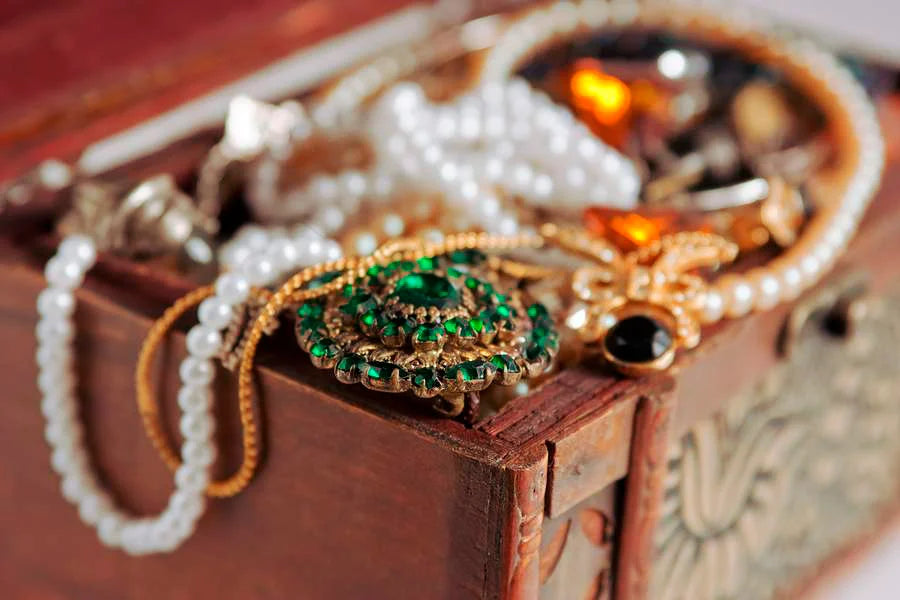
Jewelry has been around for centuries
Here is an example of the Timeline of Jewelry:
-
110.000 - 73.000 BC - Decorative sea shell beads found in the archeological digs in Morocco. They were probably used as amulets. Drilled shells have also been found in Israel, Algeria and South Africa.
-
38.000 BC - Beads made from bone and animal teeth found in France.
-
28.000 BC - Fossilized shells and ivory beads found in the East Gravettian culture, located in modern Czech Republic.
-
4400 BC - Around the time of first domesticated animals and the invention of the wheel, ancient Thracian civilization produced oldest known objects made from gold.
-
5000-30 BC - Use of copper starts a new era in jewelry production, and secrets of alluvial gold gathering arrives in Egypt around 4000 BC. They quickly start producing glazed steatite beads and countless jewelry designs based on scarab beetles, scrolls, winged birds, tigers, jackals and antelopes. Popular gemstones of that time were carnelian, feldspar, amethyst, chalcedony, lapis lazuli and turquoise.
-
400 - 30BC - Greek jewelry was made in the style of animals and shells and was infused with the amethysts, pearls, chalcedony, cornelian, garnet and emeralds.
-
500 BC - 400 AD - Ancient Roma preferred seal rings, brooches, amulets and talismans that were infused with the designs of animals and coiling snakes. Most popular gemstones were sapphires, emeralds, pearls, amber, garnets, jet and diamonds.
-
400 - 1000 AD - In European Dark Ages use of jewelry was not common, except among higher nobility and royalty.
-
1066 - 1485 - Medieval jewelry finally become widespread by the help of religion. The most famous designs of that time were hair and cloth jewelry that was worn during religious ceremonies. They were adorned with gemstones such as rubies, sapphires, pearls, emeralds, semi-precious stones and diamonds.
-
1500-1830 - Arrival of Renaissance and Georgian time period brought rise of jewelry use in entire Europe. Necklaces (single or multi strand), earrings (ordinary or with chandeliers), and many other designs were decorated with the images of animals. Intricately designed gemstones became very popular to the point that diamond jewelry became commonly used as a part of evening attire.
-
1835 - 1900 - Reign of English Queen Victoria had a profound effect of fashion and jewelry tastes in Europe.
-
Early 1900s - These years were remembered for the Art Noveau and Edwardian styles.
-
1920 - 1935 - Roaring Twenties brought the rise of the Art Deco, which introduced jewelry of vibrant colors, filled with geometrical shapes, abstract designs, cubism, modernism and oriental art. It also popularized wearing of wristwatches.
-
1939 - 1949 - Because of influence of World War II and widespread embargoes on gemstones, popular jewelry shifted to the more metal based designs adorned with patriotic motifs and semi-precious and synthetic gemstones.
-
1950s - Post war years saw the return of brightly colored jewelry, heavy use of rhinestones and big beads. Diamonds solidified its spot as the most popular gemstone. *http://www.historyofjewelry.net

WHAT IS CONSIDERED VINTAGE? The term vintage varies in todays art so it's not easily defined. Some say it’s anything 20 years or older, others claim anything younger than 50 cannot possibly be vintage. One exception to this rule can be Art Deco and Mid-century pieces — despite being almost of age for antiques, they’re often classified as vintage pieces by dealers. Since fashion cycles, vintage jewelry will always be trendy! It’s easy to incorporate into your own style, and their unique designs make for great conversational pieces! So, your mother’s unique necklace or ring is a perfect example of true vintage jewelry. When looking for a vintage piece that’s perfect for you or your loved one, keep in mind that it cannot be made! If the description of a piece states “vintage style” or “vintage-inspired” by definition it means that it is new and cannot be really vintage. If your jewelry is made of components of a vintage piece, this also means the piece itself is not vintage. WHAT IS CONSIDERED ANTIQUE? “Antique” jewelry is easily defined and quite simple because an agreement has been made for its definition: antique jewelry is at least 100 years old. Anything made prior to 1922 would be considered antique. VINTAGE VS. ANTIQUE? The difference between vintage and antique is simply that — vintage is older than 20 years, and antique is at least 100 years old. Both vintage and antique are old jewelry that has not been modified or remade recently. Antiques are more precious, delicate and rare, but vintage pieces can be worn freely to create a style all your own. When it comes to deciding which is better — vintage or antique — there’s really no clear winner. While antiques are rife with historical meaning, they are fragile and often too valuable to be worn. You might find antique pieces absolutely gorgeous, but unsuitable to today’s fashion trends. If you would like unique or precious piece of jewelry you can wear any time you’d like, you can’t go wrong with vintage jewelry. If it’s an investment or art that you are looking for antiques are will be your best bet. Another way to achieve the uniqueness of vintage and antique style is to keep your eye out for vintage or antique-inspired pieces! If you have a vintage piece you’d like repaired contact SAZ appraisals and let's talk!

